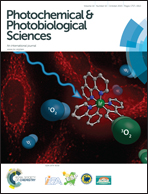Photodynamic inactivation of Escherichia coli with cationic ammonium Zn(ii) phthalocyanines†
Abstract
The aim of this work was the development of a family of novel water soluble Zinc(II) phthalocyanines (Pc) for the photodynamic inactivation of Gram-negative bacteria. Pc derivatives 1a, 2a and 3a containing trimethylammonium groups with varied number and nature of the groups at peripheral positions were synthesized by cyclotetramerization of dimethyl amino substituted phthalonitriles in the presence of zinc powder, using 1-chloronaphthalene as a solvent, followed by cationization using dimethyl sulfate. The solubility, singlet oxygen generation (1O2) and stability/photostability of each Pc were evaluated as well as the affinity to bacterial cells and their photosensitizing potential against a recombinant bioluminescent Escherichia coli strain, used as a biological model for Gram negative bacteria. The efficiency of photodynamic inactivation was assessed under white and red light at an irradiance of 150 mW cm−2. All Pc were soluble in phosphate buffer saline and in dimethyl sulfoxide and demonstrated good stability/photostability. The photochemical parameters reveal that Pc 2a and 3a are more efficient singlet oxygen producers than Pc 1a, for which singlet oxygen generation could not be demonstrated. Pc 2a and 3a caused photosensitization in E. coli. The inactivation factors attained with red light were, however, generally higher than those with white light. Under red light Pc 3a and 2a caused, respectively, 5.6 and 4.9 log reduction in the bioluminescence of the E. coli while, with white light, the corresponding inactivation factors were 2.5 and 0.5 log. The order of the PDI efficiency (3a > 2a ⋙ 1a) was determined by the combined effect of solubility, singlet oxygen generation ability and affinity to bacterial cells. Ammonium phthalocyanines with eight charges or containing halogen atoms such as chlorine, when irradiated with red light can, therefore, be regarded as promising photosensitizers for the inactivation of Gram-negative bacteria.


 Please wait while we load your content...
Please wait while we load your content...